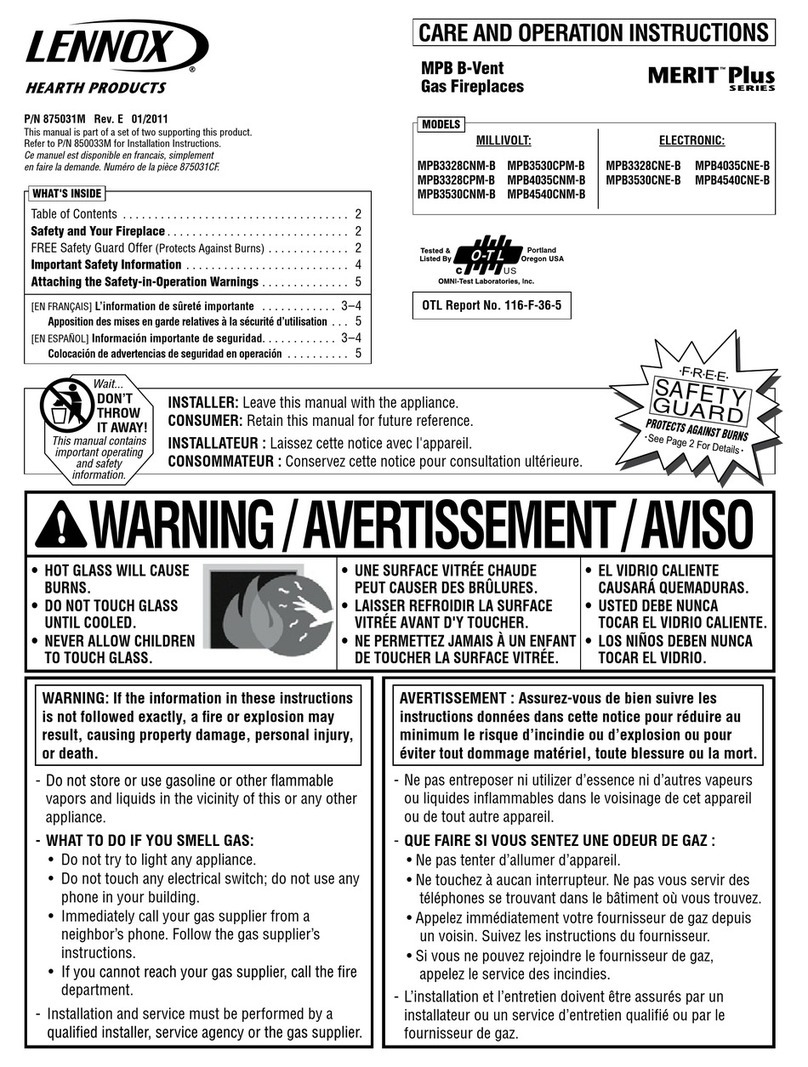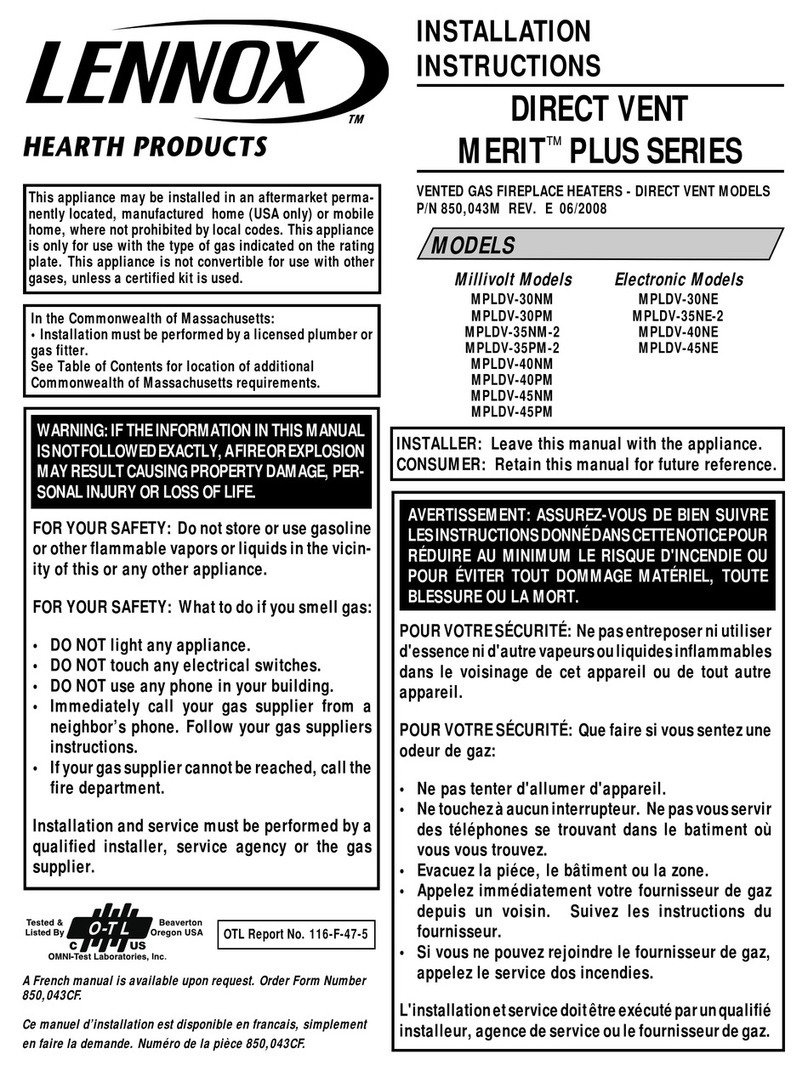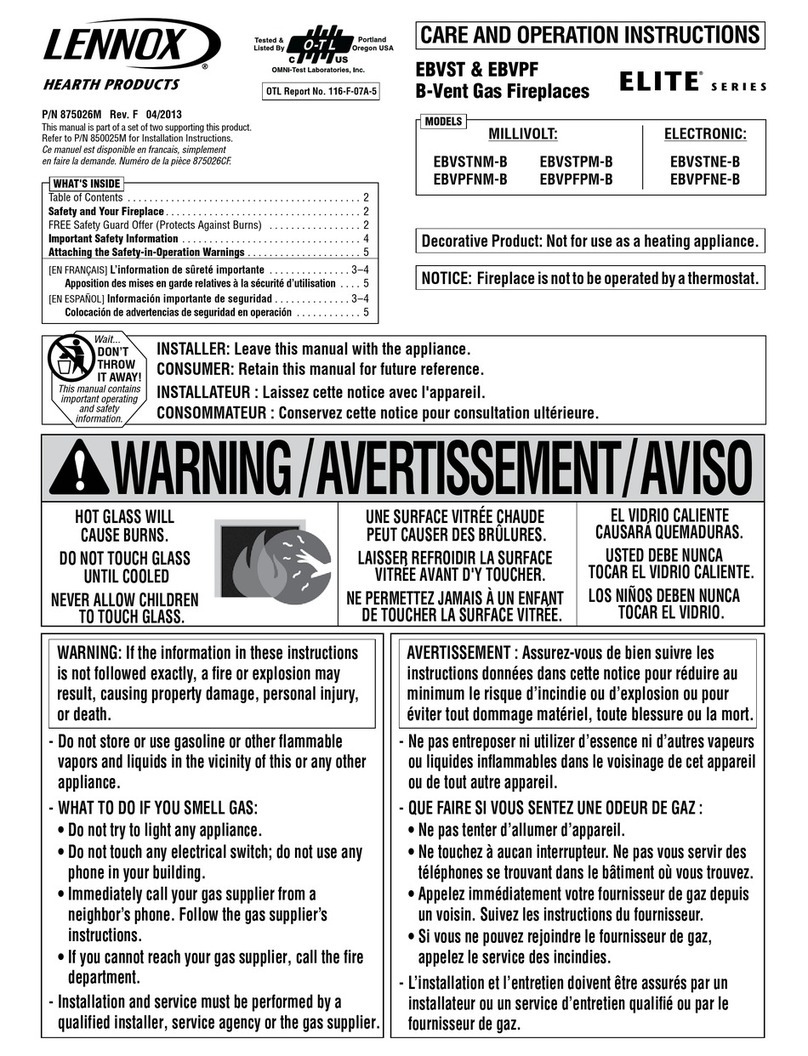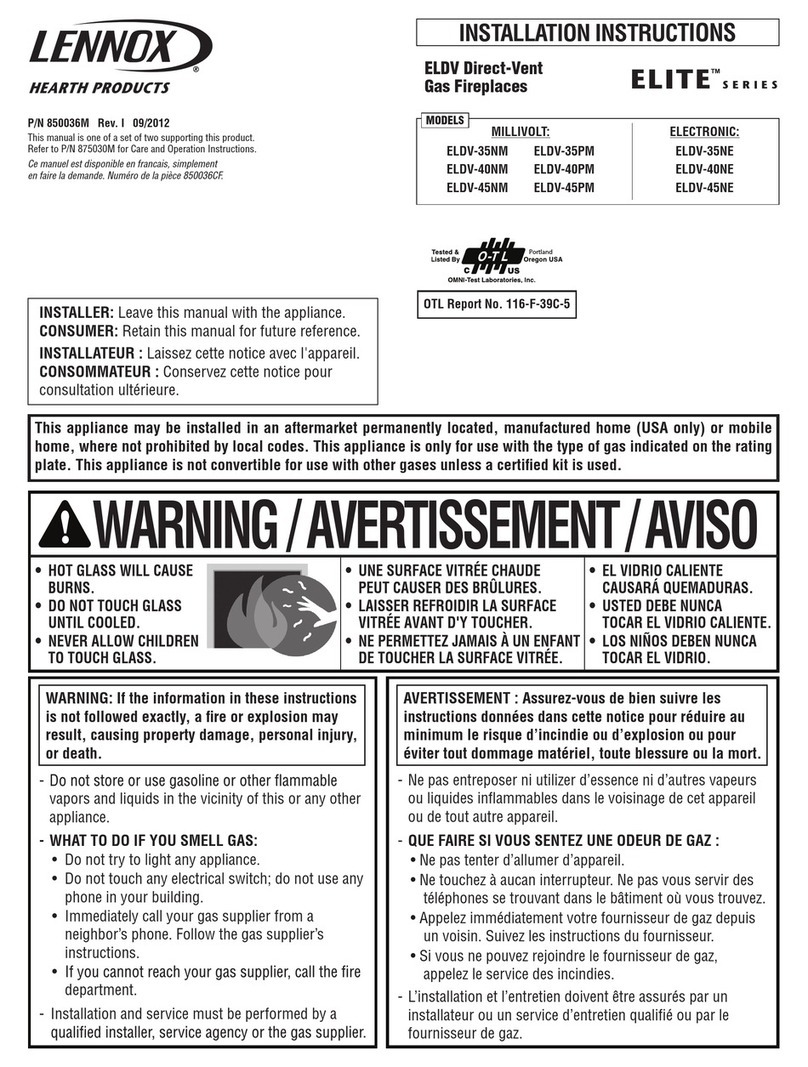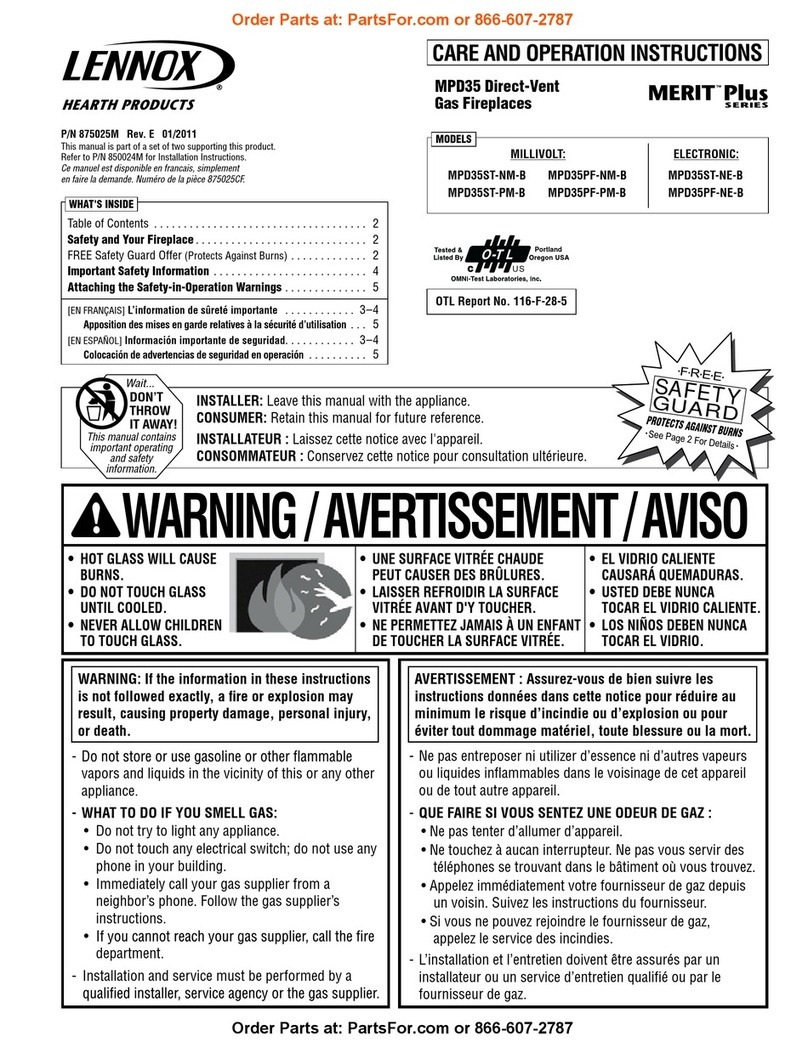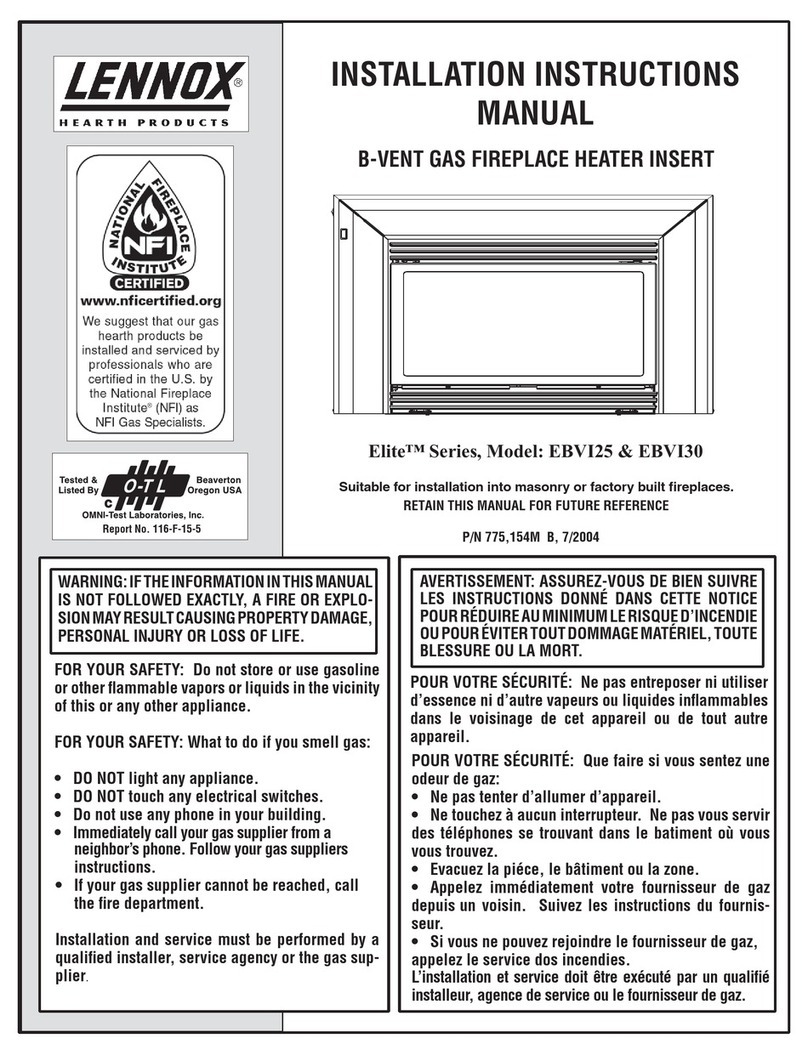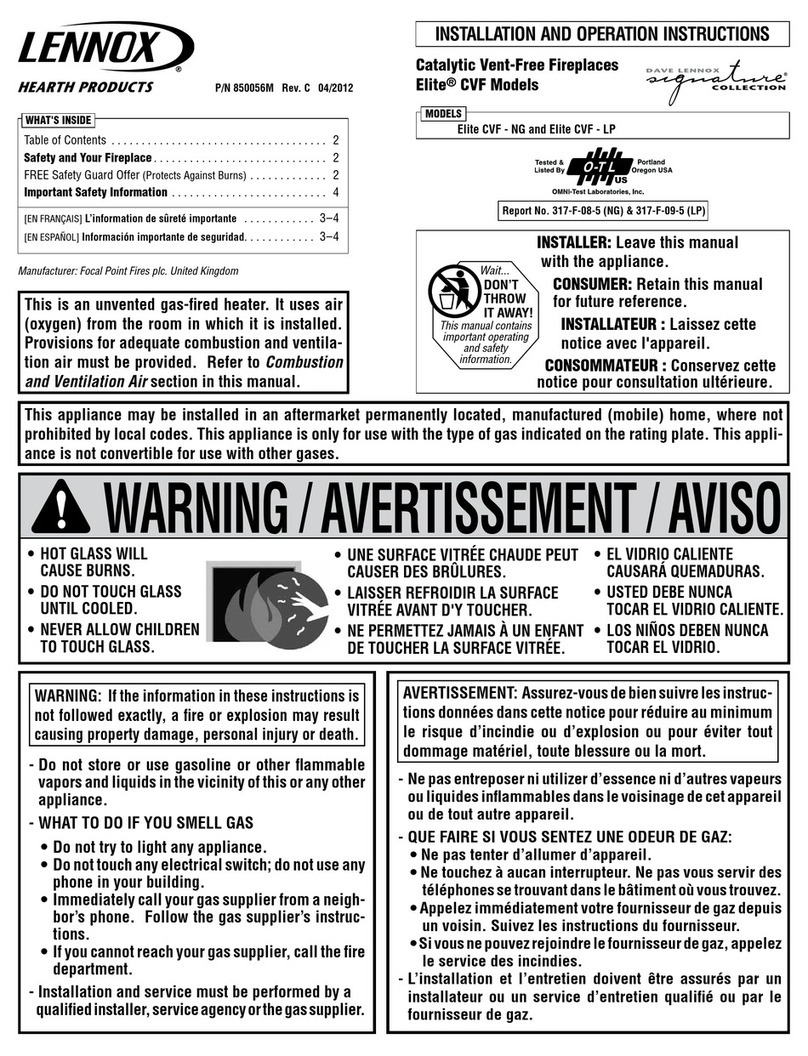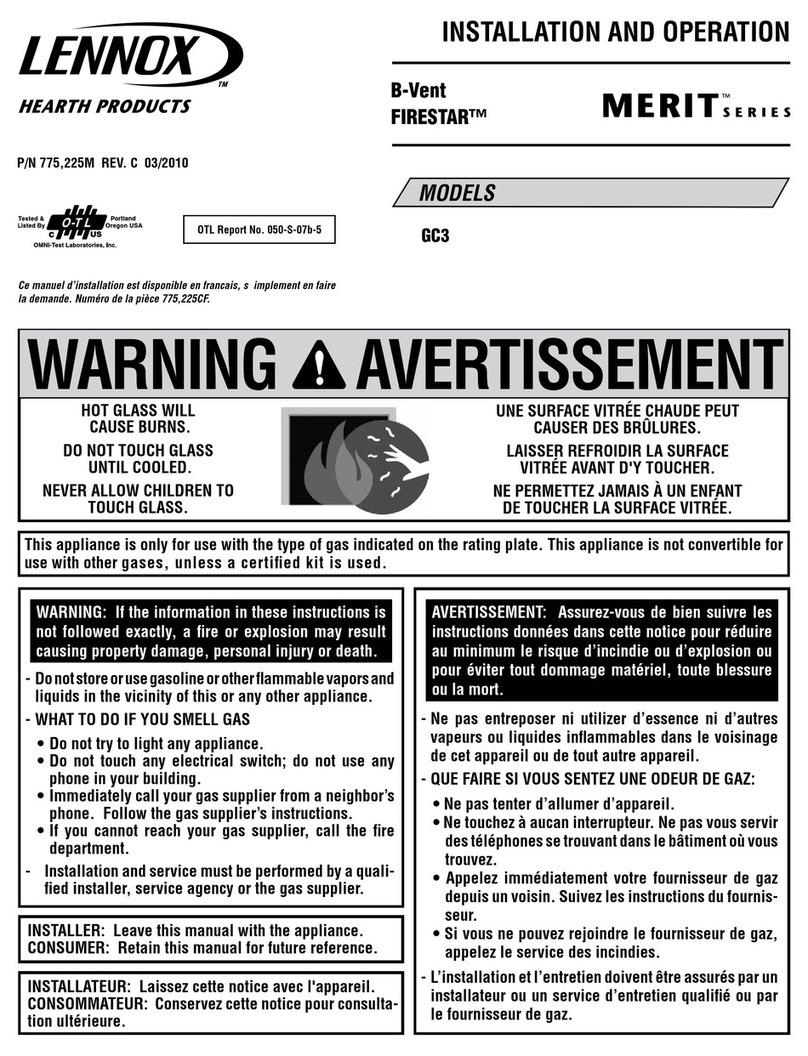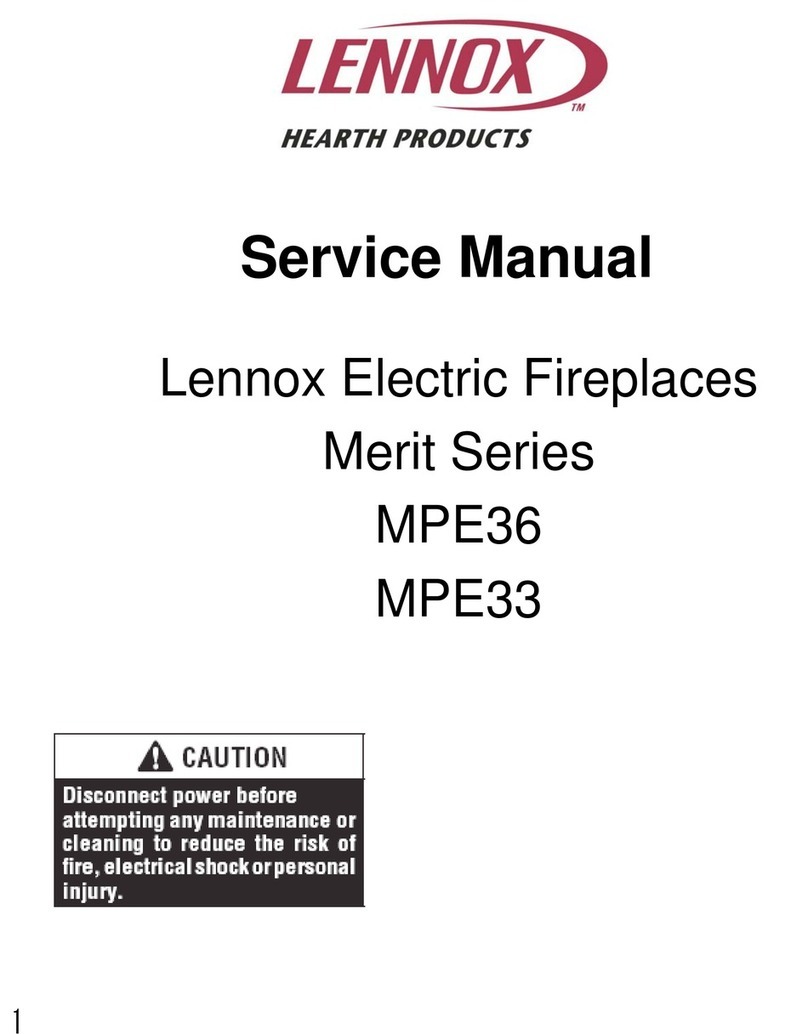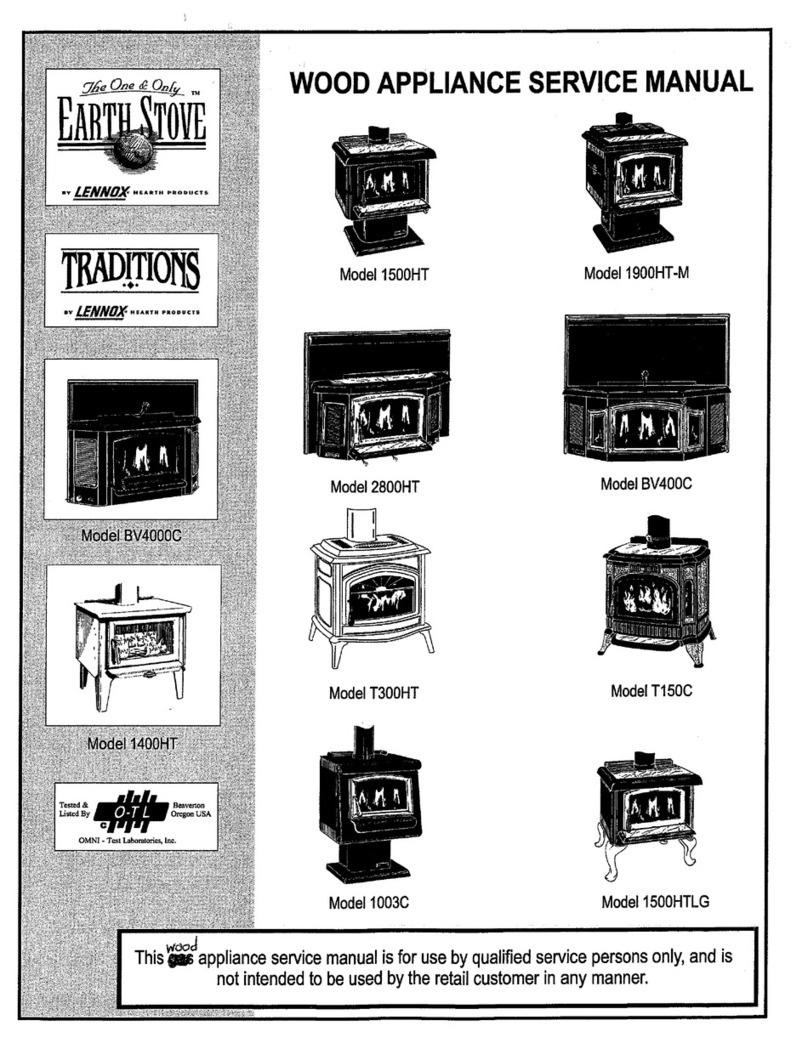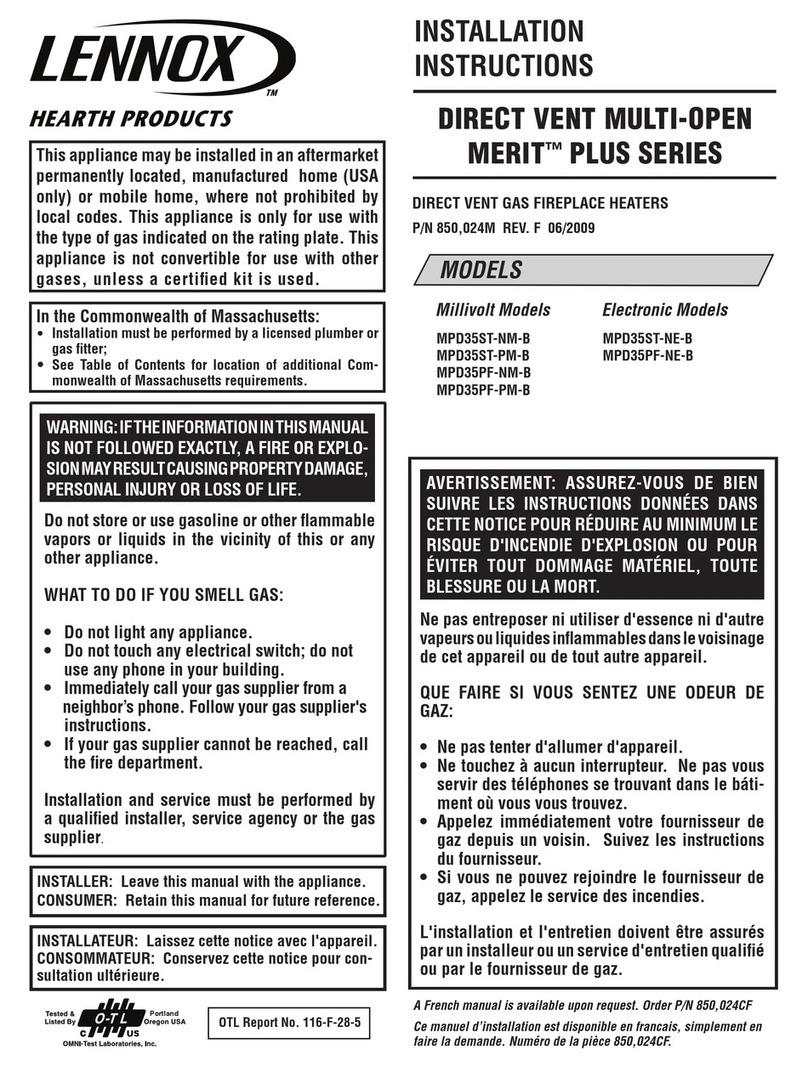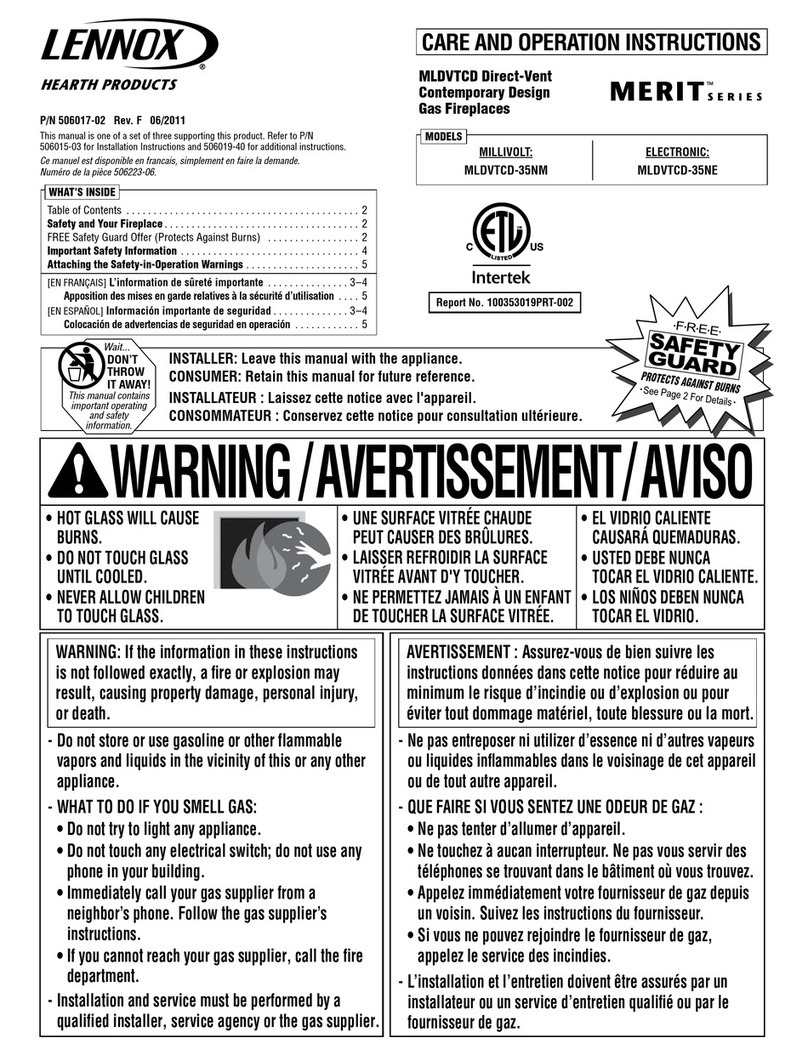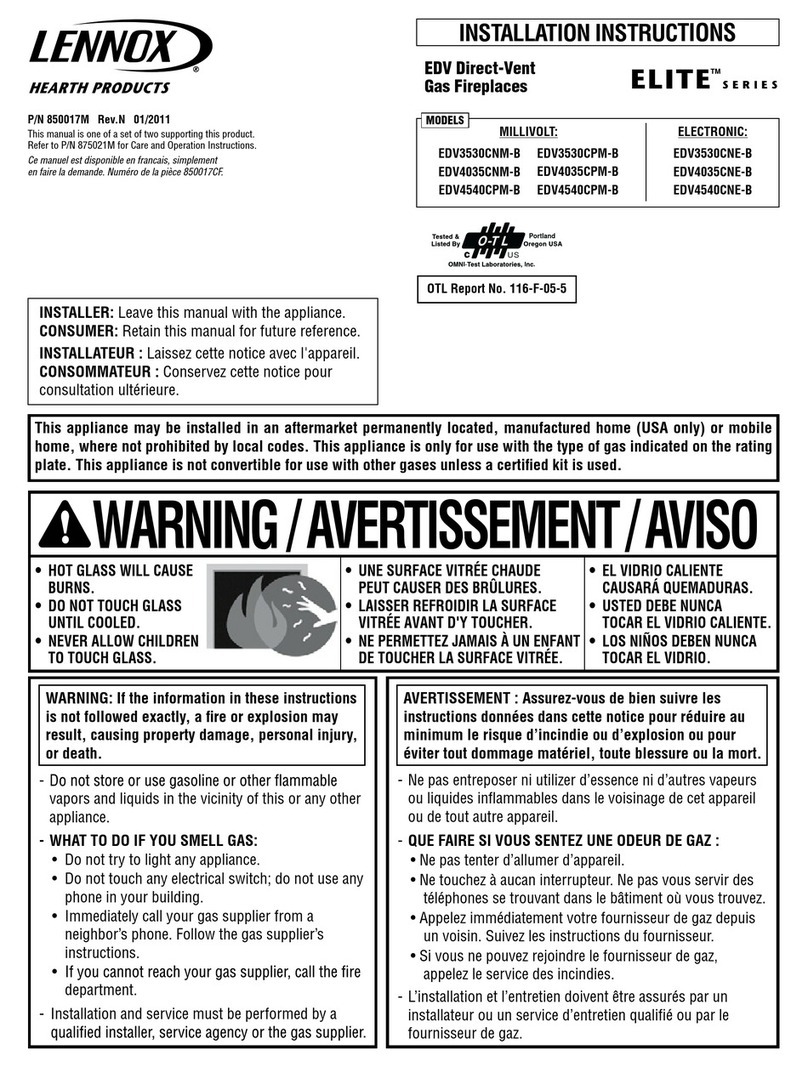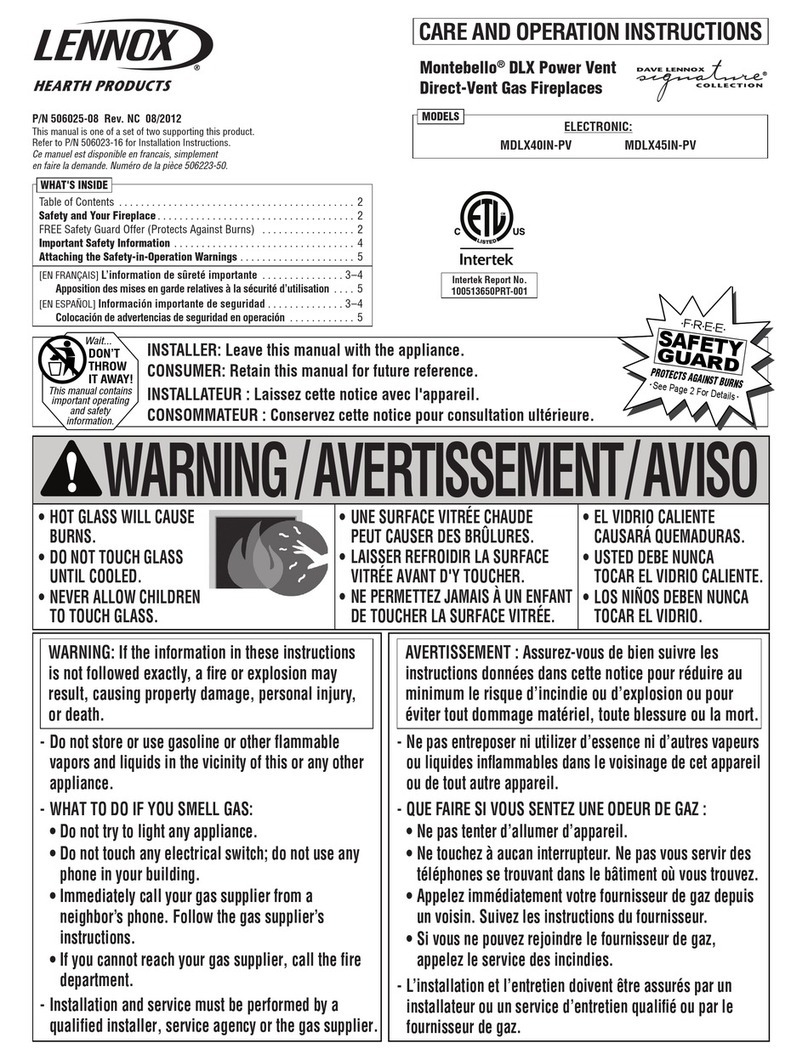
3
LENNOX HEARTH PRODUCTS • MERIT PLUS® DIRECT VENT GAS FIREPLACES (MPD33/35/40/45) • INSTALLATION INSTRUCTIONS
NOTE: DIAGRAMS & ILLUSTRATIONS ARE NOT TO SCALE.
WARNING
Failure to comply with these
installation instructions will
result in an improperly installed
and operating appliance, voiding
its warranty. Any change to this
appliance and/or its operating
controls is dangerous.
WARNING
Clothing or other flammable
material should not be placed
on or near the appliance.
AVERTISSEMENT
On ne devrait pas placer de
vêtements ni d’autres matières
inflammables sur l’appareil ni à
proximité.
NOTE: Installation and repair should be done
by a qualified service person. The appliance
should be inspected before use and at least
annually by a professional service person.
More frequent cleaning may be required due
to excessive lint from carpeting, bedding
material,etcetera.Itisimperativethatcontrol
compartments, burners and circulating air
passageways of the appliance be kept clean.
Remarque: L’installation et la réparation
devrait être confiées à un technicien
qualifié. L’appareil devrait faire l’objet
d’une inspection par un technicien
professionnel avant d’être utilisé et au
moins une fois l’an par la suite. Des
nettoyages plus fréquents peuvent être
nécessaires si les tapis, la literie, et
ceteraproduisentunequantitéimportante
de pous-sière. Il est essentiel que les
compartiments abritant les commandes,
les brûleurs et les conduits de circulation
d’air de l’appareil soient tenus propres.
Do not use this appliance if any part has
been under water. Immediately call a
qualified service technician to inspect the
appliance and to replace any parts of the
control system and any gas control which
has been under water.
Ne pas utiliser cet appareil s’il a été
plongé, même partiellement, dans
l’eau. Appeler un technicien qualifié
pour inspecter l’appareil et remplacer
toute partie du système de commande
et toute commande qui a été plongée
dans l’eau.
Onlytrim kit(s)suppliedby themanufacturer
shall be used in the installation of this
appliance.
Seules les trousses de garniture fournies
parlefabricant doiventêtreutiliséespour
l’installation de cet appareil.
Models Input Rate (BTU/HR)
Nat. Gas Prop. Gas
MPD33 17,500 high
11,700 low 17,500 high
14,000 low
MPD35 20,000 high
12,800 low 20,000 high
15,200 low
MPD40 27,000 high
18,500 low 27,000 high
21,500 low
MPD45 29,000 high
20,500 low 29,000 high
22,500 low
Table 1 - Input (BTU/HR) Gas Valves
(Millivolt and Electronic)
WARNING
Improper installation or use of
this appliance can cause serious
injury or death from fire, burns,
explosion or carbon monoxide
poisoning.
WARNING
Failure to position the parts in
accordance with these diagrams
or failure to use only parts
specifically approved with this
appliance may result in property
damage or personal injury.
AVERTISSEMENT
Risque de dommages ou de
blessures si les pièces ne sont
pas installées conformément à
ces schémas et ou si des pièces
autres que celles spécifiquement
approuvéesaveccetappareilsont
utilisées.
These appliances comply with National Safety
Standards and are tested and listed by OMNI-
TestLaboratories,Inc.(ReportNo.116-F-13g-5)
to ANSI Z21.88-2009 (in Canada, CSA-2.33-
2009),andCAN/CGA-2.17-M91(R2009)inboth
USAandCanada,asventedgasfireplaceheaters.
Both millivolt and electronic versions of
these appliances are listed by OMNI-Test
Laboratories for installation in bedrooms
and Manufactured Homes.
Misc. Codes / Standards
The Installation must conform to local codes
or, in the absence of local codes, with the
National Fuel Gas Code, ANSI Z223.1 / NFPA
54 - latest edition (In Canada, the current CAN/
CGA-B149.1 installation code).The appliance,
when installed, must be electrically grounded
and wired in accordance with local codes or, in
the absence of local codes, with the National
Electrical Code, ANSI/NFPA 70 - latest edition,
or the Canadian Electrical Code, CSA C22.1 -
latest edition.
Provide adequate clearances around air
openings and adequate accessibility clearance
forserviceandproperoperation.Neverobstruct
the front or back openings of the appliance.
These appliances are designed to operate on
natural or propane gas only. The use of other
fuels or combination of fuels will degrade
the performance of this system and may be
dangerous.
These fireplaces are designed as supplemental
heaters. Therefore, it is advisable to have an
alternate primary heat source when installed
in a dwelling.
These appliances must not be connected to a
chimney or flue serving a separate solid fuel
burning appliance.
Both millivolt and electronic systems can be
operated during a power outage, and feature
manuallyoperatedhi-lowflamecontrol.TheBTU
Input for these appliances is shown in Table 1.
WARNING
Improper installation, adjust-
ment, alteration, service or
maintenance can cause injury
or property damage. Refer to
this manual. For assistance or
additional information consult
a qualified installer, service
agency or the gas supplier.
AVERTISSEMENT
Tout écran ou protecteur retiré
pour permettre l’entretien de
l’appareil doit être remis en
place avant de mettre l’appareil
en marche.
WARNING
Any safety screen or guard
removed for servicing the appli-
ance must be replaced prior to
operating the appliance.
